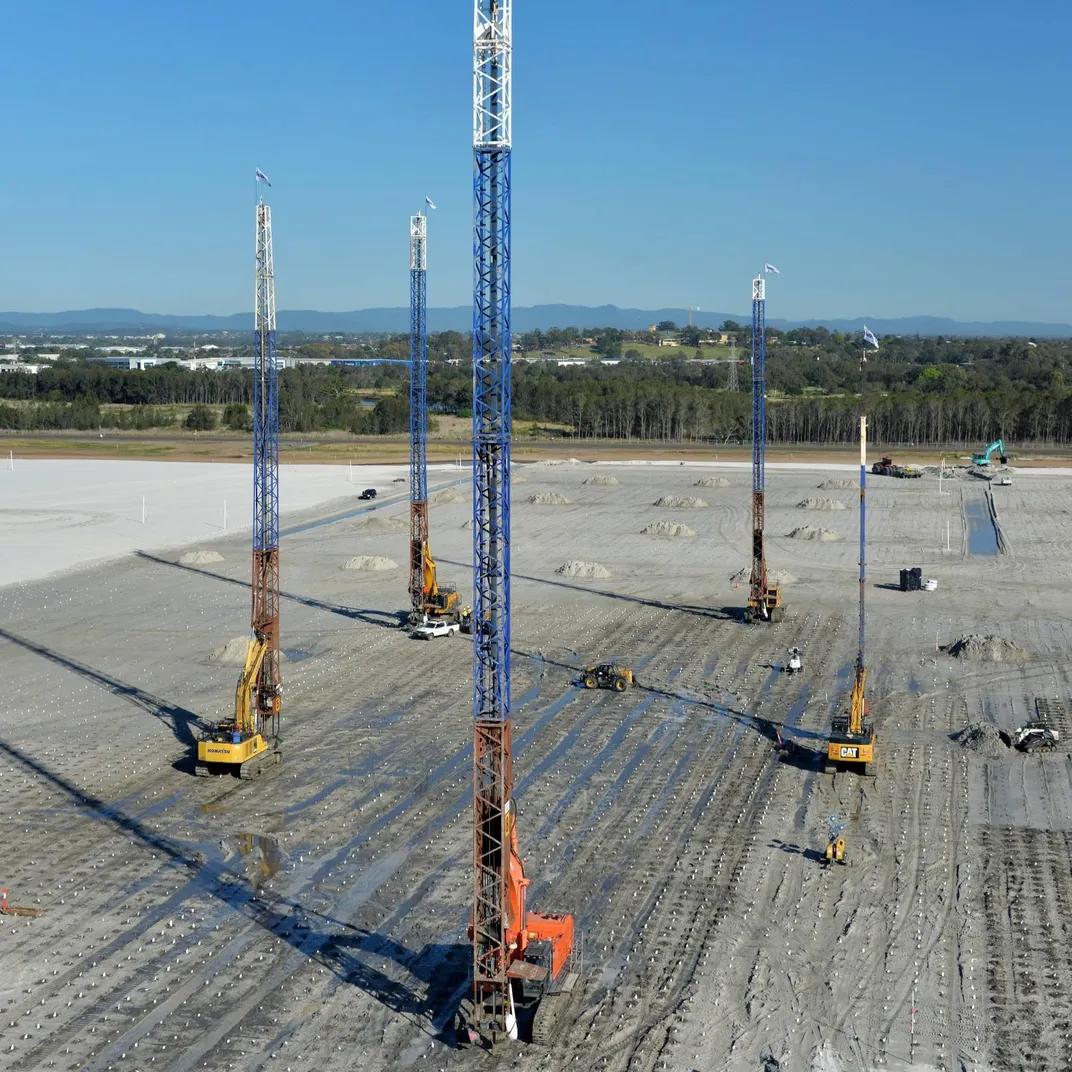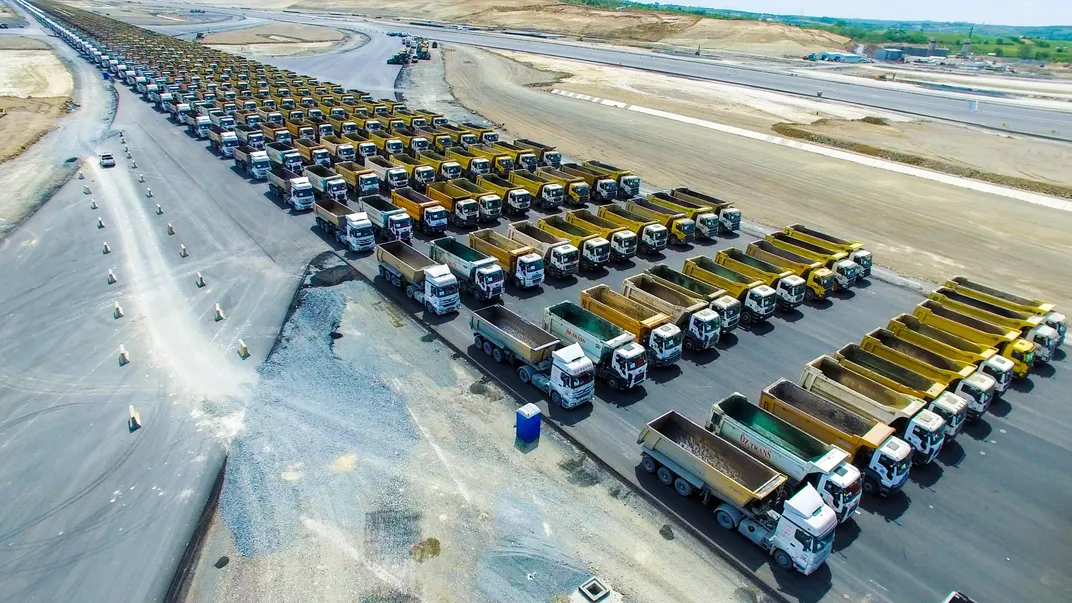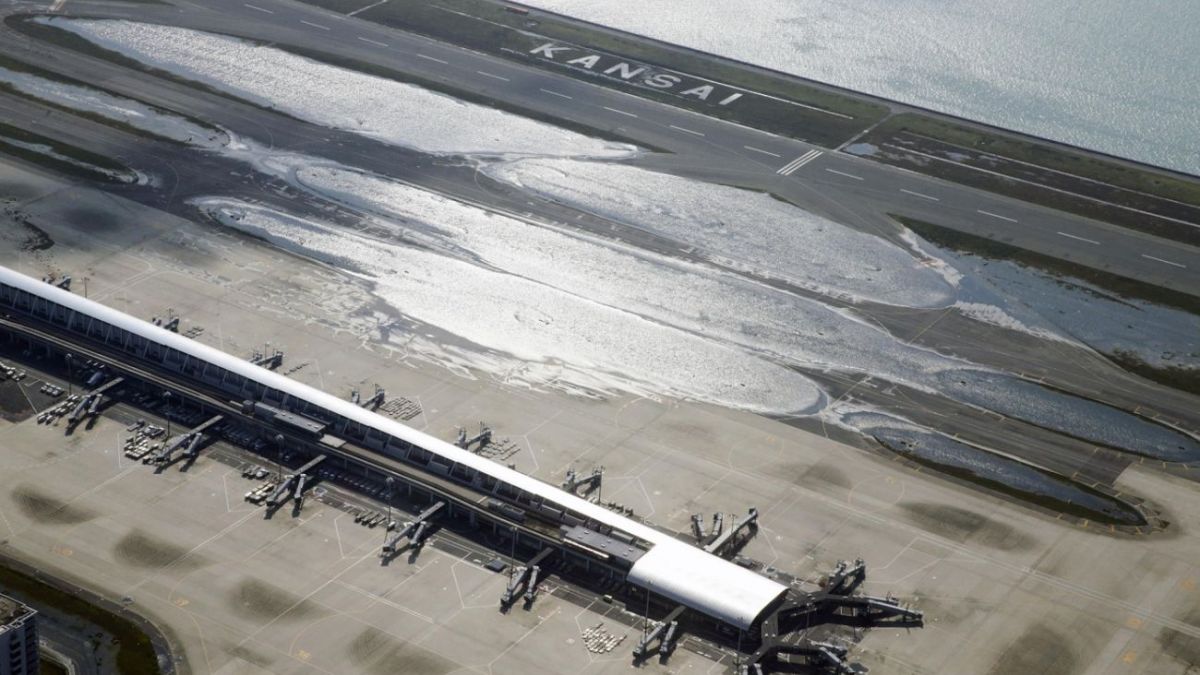In recent years, new airports have emerged in challenging locations around the globe.
In the Maldives archipelago, a sprawling expansion of its capital city’s airport has risen from the Indian Ocean.
In 2020, a runway opened in an estuary of the Brisbane River in Australia, atop ground that engineers described as no more stable than toothpaste.
Like dozens of airports already built on land reclaimed from water, these airports are expected to sink. The only question is how fast.
Leading the race to the bottom is Kansai International Airport, which serves the Japanese city of Osaka and occupies two artificial islands in Osaka Bay.
/https://tf-cmsv2-smithsonianmag-media.s3.amazonaws.com/filer/33/0d/330d7396-5e36-4ed2-94e0-7fbf80bb4ebd/06c_jj2018_kansaisatelliteiss045_live.jpg)
Since its opening in 1994, Kansai has sunk 38 feet. Engineers initially predicted the islands would evenly settle, or subside, over a 50-year period before stabilizing at 13 feet above sea level.
This minimum elevation is required to prevent flooding in case of a breach in the encircling seawall. However, portions of the first island reached that threshold within just six years.

At least $150 million has been spent raising the seawall, but some engineers predict that by 2056, sections of the two artificial islands may sink an additional 13 feet, reaching sea level.
“When Kansai airport was constructed, the amount of soil to reclaim the land was determined based on necessary ground level and subsidence estimation over 50 years after construction,” says Yukako Handa, communications director for Kansai Airports.

Handa explains that engineers were shocked by the discrepancy between laboratory estimates of soil consolidation and the actual rate once thousands of tons of fill were deposited into the bay.
The Construction Process
Reclaimed land is like a wet sponge. Before it can support the enormous weight of airport buildings, it must be transformed into a dry, dense foundation.

To achieve this, Kansai’s construction crews laid sand five feet deep atop the clay seabed and installed 2.2 million vertical pipes, each nearly 16 inches in diameter.
After pounding the pipes into the clay, they filled them with sand to absorb moisture from the surrounding soil and deeper layers.
In other reclamation projects, fabric is pushed into the pipes to soak up moisture like a wick. When the pipes are withdrawn, the drains remain.
Next, new soil was loaded on top of the sand layer.

Engineers dredged soil from Osaka Bay, quarried more from nearby mountains, and even barged it in from China and Korea to build up layers.
The mass of soil squeezed moisture into the less-dense sand or wicks.
The dense, non-porous layers below the new soil allowed moisture to travel only horizontally through capillary action into the wick.
Water then crept upward to the surface to be drained or evaporate.
As it left the soil, the layers consolidated, becoming stiffer and less likely to deform.
In Brisbane, Australia, 330,000 pipes containing fabric wicks were drilled 85 feet into the Brisbane River to drain water and consolidate the sand until it was dense enough to support a runway.
Engineering Challenges
A seawall encircling Kansai was built to protect the operational area.
Made of 48,000 concrete blocks and rubble, the wall is anchored in steel chambers weighing hundreds of tons.
As dredging and filling continued, added layers reached up to 65 feet above sea level.

At several stages, operations paused to allow the new layers to consolidate and sink.
Once the layers stabilized at a height predicted to remain 13 feet above sea level for 50 years, 900 columns, resting on hydraulic jacks, were driven into the soil.
Building foundations rest on these columns, which can be adjusted by the jacks to offset variations in the rate of settling.
Work on Kansai’s islands began in 1987. By 1990, when the first island had sunk 27 feet instead of the predicted 19, engineers were alarmed.
To save the airport from the sea, workers excavated below the passenger terminal, inserted iron plates beneath the hydraulic jacks, and raised the columns in stages.
Even with these measures, the airport is likely to continue settling, perhaps for centuries, but at a much slower rate.
Every two years, Kansai’s jacks are readjusted if necessary. Each of the 900 columns has a meter that engineers can check for tilt.
Handa says there is no official estimated life calculated for Kansai.
However, Gholamreza Mesri, a professor of engineering at the University of Illinois at Urbana-Champaign, predicted that island 2 could reach its warning point of 13 feet above sea level as early as 2023.

If a typhoon strikes Kansai directly and waves slip over its seawall, its runways and buildings will be below water.
Beyond the rate of sinking, engineers are also concerned about its unevenness; different areas on Kansai’s islands are sinking at different rates.
In the center of Kansai’s passenger terminal—located on island 1—engineers measured a higher degree of sinking at the basement level than at the ends of the building.
Workers coped with uneven sinking by paving the airport runways with asphalt rather than concrete to minimize cracks or buckles.
Costs and Justifications

When Kansai opened in 1994, its cost was estimated at $8 billion, but by 2008, repairs and modifications had swelled the figure to $20 billion. Why risk such expense to build airports on reclaimed land?
When planning to build or expand an airport, cities or other entities—in Kansai’s case, Japan’s transport ministry—aim to acquire land close to the city and its transportation links, which is expensive and sought after for various uses.
They must factor in not only the cost of land and construction but also the environmental toll of construction and the human toll of airliner noise, including the expense of relocating and compensating residents and affected industries.
Against these costs, builders weigh the airport’s role in the economy.
Perhaps with a touch of engineering hubris, builders have determined that creating new land close to a city center but offshore, away from populated areas, is less expensive in the long run than building airports where people live.
Last May, 1,453 trucks paraded into the Istanbul New Airport to symbolize its staggering landfill over marshland.
“Kansai was planned as a fundamental solution to the problem of aircraft noise pollution surrounding the Osaka Itami International Airport,” says T. Furudoi of the Kansai International Land Development Company, which managed the Kansai property in 2006.
The airport is currently managed by a consortium of private corporations led by Kansai Airports, which pays Japan’s transport ministry $350 million annually for operating rights.
As soon as the first jet landed at Itami in 1964, residents of Osaka began protesting and filing lawsuits, eventually winning compensation from Japan’s supreme court.
For Kansai, Ministry of Transport planners chose a site three miles offshore, situating it so that airliners would fly the entire arrival and departure pattern over unpopulated areas.
Current Status and Future
Keeping Kansai International Airport high and dry has been expensive, but the airport has fulfilled its purpose: connecting Osaka to the world.
In 2016, more than 26 million passengers used Kansai, making it one of the 30 busiest airports in Asia.
In 2001, the airport was honored by the American Society of Civil Engineers as one of the civil engineering monuments of the millennium.
Despite the challenges, Kansai International Airport remains a crucial gateway for Japan.
The ongoing efforts to maintain its structural integrity and address subsidence issues underscore the ingenuity and determination of engineers and planners.
However, the future of Kansai and similar airports built on reclaimed land remains uncertain, as climate change and rising sea levels present additional risks.
The story of Kansai International Airport serves as a testament to human innovation and the complexities of balancing technological advancement with environmental and logistical challenges.
As the world continues to develop infrastructure in increasingly difficult conditions, the lessons learned from Kansai will undoubtedly inform future projects and the ongoing quest for sustainable development.
Conclusion
Japan’s Kansai International Airport, a marvel of modern engineering, faces the daunting challenge of subsidence.
Despite the significant costs and ongoing maintenance, the airport has successfully connected Osaka to the world.
As engineers and planners continue to address the issues of sinking and stability, Kansai stands as a symbol of human ingenuity and the ever-present struggle to conquer nature’s challenges.
The future of such ambitious projects will depend on the ability to innovate and adapt in the face of environmental changes and technological advancements.

